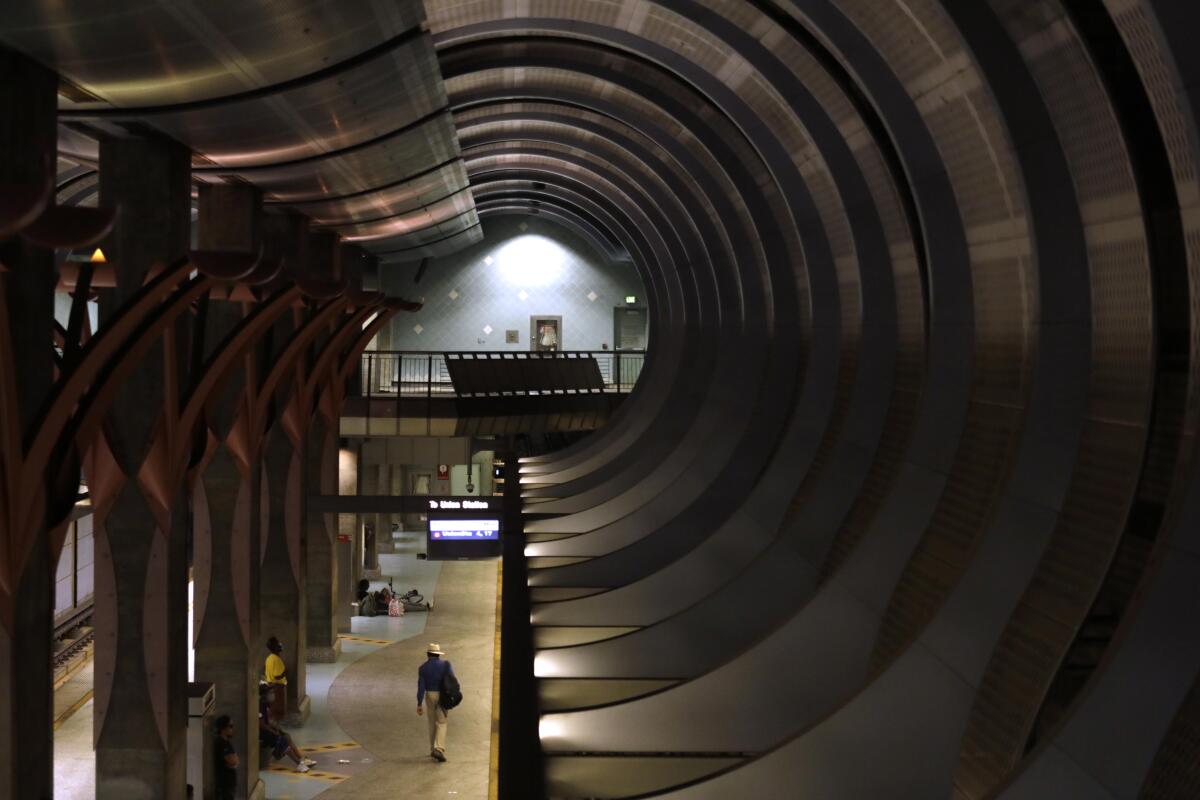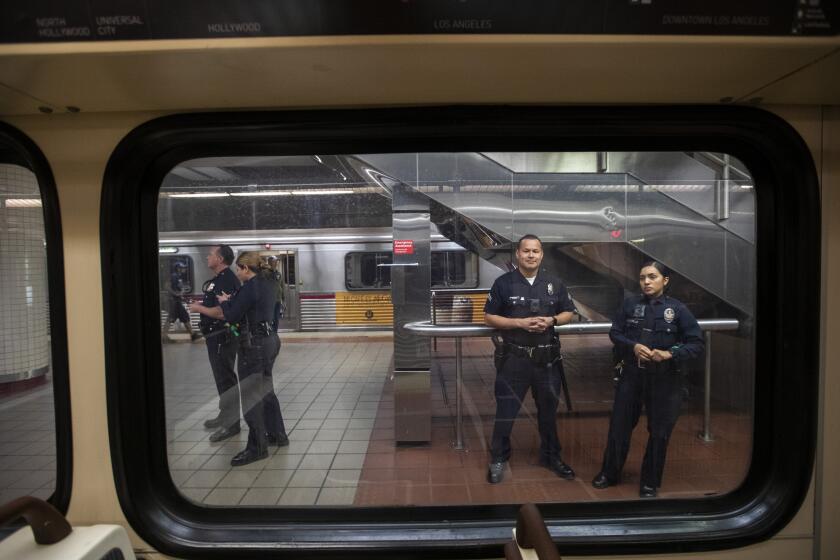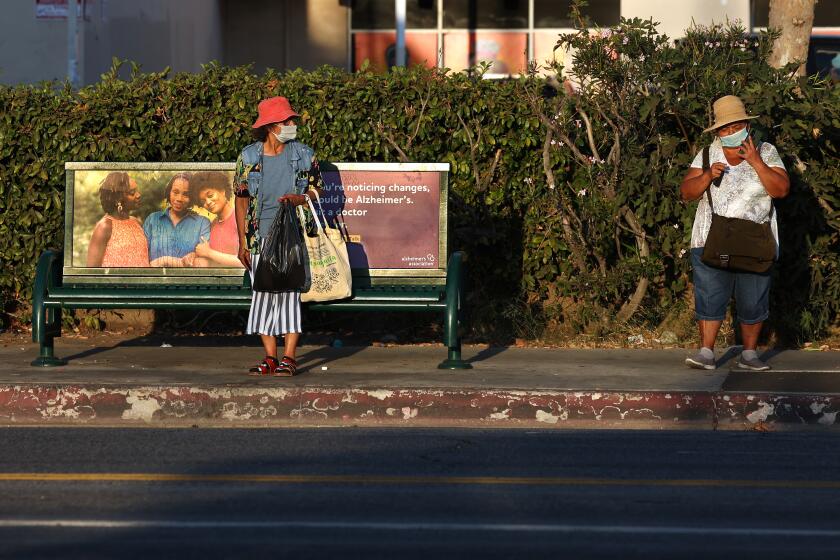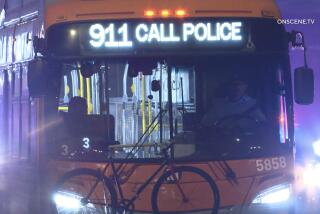Editorial: Metro riders need safer trains and buses. That doesn’t necessarily mean more police

In 2017, with ridership declining and passengers complaining about the lack of security, the Los Angeles County Metropolitan Transportation Authority decided to significantly increase policing. The agency boosted funding and hired the Los Angeles and Long Beach police departments to patrol the region’s bus and subway system, along with the Sheriff’s Department.
Six years later, violent crime is up. Drug use is prevalent, particularly on the subways; 22 people have died on the system since January, mostly from suspected overdoses, which is more than the total number of deaths on the system last year. An average of 13 bus operators are assaulted on the job every month. And in surveys, customers consistently name safety as a top concern and a major reason they ride less or have stopped riding Metro altogether.
Earlier this year, in an attempt to restore a sense of order and safety at the Westlake/MacArthur Park stop, Metro began blasting classical music over the public address system to discourage drug users and unhoused people from hanging out in the station. It’s a sign of Metro leaders’ desperation and only makes public transit even more hostile to riders. The security issues, crime and disorder on the system have the biggest impact on the people who rely on public transit to get to schools and jobs, primarily low-income people of color. It’s not fair that riders have to fear for their person and property just to go about their daily lives.
In survey after survey, people say they want more security on transit. The question is who should provide it and how to make all passengers feel safe.
Metro cannot attract and retain riders if people do not feel comfortable riding the bus or train. Disorder, rising crime and declining confidence in the system pose an existential crisis to Metro, which is in the midst of a multibillion-dollar expansion that is central to making a more walkable, bikeable, transit-friendly city so people can drive less to reduce emissions and fight climate change. Solving the safety problem is essential. The question is how?
Historically, the default response to rising crime and lack of security would have been to increase spending on police patrols. But Metro tried that and it has been a failure.
Now Metro is ramping up a more holistic approach to public safety that shows promise. This month, Metro put 300 ambassadors on the system to give customers directions or answer questions, and to call for security officers, service providers and law enforcement when necessary. The agency is also going to hire more security officers to check fares and enforce the code of conduct, contract with more homeless outreach teams, and add lighting and cleaning crews to stations. Advocates are also pushing for bathroom and elevator attendants, and more frequent service.
It’s recognition that many of the problems afflicting the system are larger societal challenges — homelessness, an opioid epidemic, lack of mental health care — that need a public health and social services response, not a cop or an arrest.
What should be a simple, basic amenity of bus service – a bench to sit on and some shade while waiting – is still a rarity in most areas of the region.
That said, Metro does need law enforcement to help prevent and respond to violence, and to back up ambassadors and other Metro employees in dangerous situations. In perhaps the biggest change, Metro will consider creating its own transit police department to replace or reduce its reliance on the sheriff, LAPD and Long Beach Police Department within three years. It’s worth considering because the current situation hasn’t served riders well.
The 2017 agreement with the LAPD, Long Beach Police Department and sheriff was supposed to nearly double the number of armed officers on the system, slash response times and provide a deterrent presence on the system.
Instead, according to an Office of Inspector General audit, the sheriff’s deputies assigned to Metro ride the trains only 12 out of 178 weekly shifts, providing little visibility on the system. Deputies primarily work from patrol cars outside stations and near bus stops. And while LAPD officers spend more time in stations, the audit found more than half of emergency calls on the system were answered by regular patrol officers not assigned to Metro.
During a meeting last week, Metro board members noted the agency is spending $150 million to $200 million a year on policing, and asked why law enforcement agencies haven’t assigned more officers to ride the system in response to concerns. Chief safety officer Gina Osborn explained: “I was told they weren’t going to have a bus company tell them how to deploy their resources.”
By creating an in-house police department, Metro would be able to decide where and how officers patrol the system, as well as set a culture of community and customer-oriented policing. Metro doesn’t necessarily need more police officers than currently contracted to patrol the system, but it does need officers that actually patrol the areas of greatest need and who can work seamlessly with transit operators, ambassadors, security guards and homeless outreach and mental health crisis teams.
But Metro leaders should proceed carefully. It’s neither easy nor cheap to create a police department from scratch. The concern is that a new in-house police department could end up consuming a big chunk of Metro’s budget, leaving less money for ambassadors, cleaning crews and more frequent service — which are also central to making the bus and train experience better for riders.
The transit system is at an inflection point. Metro cannot recover from the pandemic ridership decline or become the successful transit agency the region needs as long as riders do not feel safe and comfortable on buses and trains. The future of Metro is on the line.
More to Read
A cure for the common opinion
Get thought-provoking perspectives with our weekly newsletter.
You may occasionally receive promotional content from the Los Angeles Times.












